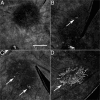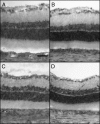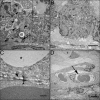A rat model for choroidal neovascularization using subretinal lipid hydroperoxide injection
- PMID: 20395434
- PMCID: PMC2877867
- DOI: 10.2353/ajpath.2010.090989
A rat model for choroidal neovascularization using subretinal lipid hydroperoxide injection
Abstract
The purpose of this study was to develop and characterize a rat model of choroidal neovascularization (CNV) as occurs in age-related macular degeneration. The lipid hydroperoxide 13(S)-hydroperoxy-9Z,11E-octadecadienoic acid (HpODE) is found in submacular Bruch's membrane in aged humans and has been reported to generate neovascularization in a rabbit model. Three weeks after a single subretinal injection of 30 microg of HpODE, eyes of Sprague-Dawley rats were harvested. Follow-up fluorescein angiography was done on other animals until 5 weeks postinjection. Histological studies, immunohistochemical staining, and flatmount choroids for CNV measurements were performed. In addition, we used murine neuronal, bovine endothelial, and human ARPE19 cells for testing the in vitro effects of HpODE. CNV developed in 85.7% of HpODE-injected eyes. The neovascular areas were significantly greater in HpODE-injected eyes compared with those in control eyes (P = 0.023). The CNV had maximum dye leakage at 3 weeks, which subsided by the 5th week. Histologically, CNV extended from the choriocapillaris into the subretinal space. ED1-positive macrophages were recruited to the site. In vitro assays demonstrated that only 30 ng/ml HpODE induced cell proliferation and migration of endothelial cells. HpODE-induced CNV was highly reproducible, and its natural course seems to be ideal for evaluating therapeutic modalities. Because HpODE has been isolated from aged humans, the HpODE-induced rat model seems to be a relevant experimental model for CNV in age-related macular degeneration.
Figures











References
-
- Ambati J, Ambati B, Yoo S, Ianchulev S, Adamis A. Age-related macular degeneration: etiology, pathogenesis, and therapeutic strategies. Surv Ophthalmol. 2003;48:257–293. - PubMed
-
- Green WR, Enger C. Age-related macular degeneration histopathologic studies. Ophthalmology. 1993;100:1519–1535. - PubMed
-
- Goldberg MF. Editorial: Bruch’s membrane and vascular growth. Invest Ophthalmol. 1976;15:443–446. - PubMed
Publication types
MeSH terms
Substances
Grants and funding
LinkOut - more resources
Full Text Sources
Other Literature Sources
Medical

